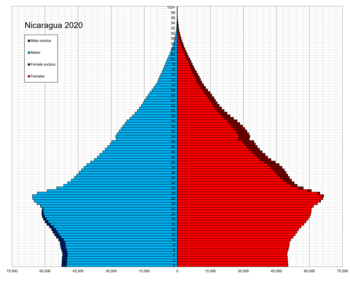
Back Население на Никарагуа Bulgarian Demografia de Nicaragua Catalan Demografía de Nicaragua Spanish Démographie du Nicaragua French Stanovništvo Nikaragve Croatian ნიკარაგუის დემოგრაფია Georgian 니카라과의 인구 Korean Nikaragvos demografija Lithuanian Demografia da Nicarágua Portuguese Demographics of Nicaragua SIMPLE

| Demographics of Nicaragua | |
|---|---|
| Population | 6,850,540 (2021 est.)[1][2] |
| Male population | 2,839,168 |
| Female population | 2,836,188 |
| Population growth | 1.855% |
| Birth rate | 18.9/1,000 (2020 est.) |
| Death rate | 5.1/1,000 (2020 est.) |
| Infant mortality rate | 11.861/1,000[3] |
| Life expectancy | 74.8 years[3] |
| Nationality | Nicaraguan |
| Demographic bureaus | INEC |
According to the 2022 revision of the World Population Prospects[1][2], Nicaragua has a population of 6,850,540.[1][2].According to a 2014 research published in the journal Genetics and Molecular Biology, European ancestry predominates in 69% of Nicaraguans, followed by African ancestry in 20%, and lastly indigenous ancestry in 11%.[4] A Japanese research of "Genomic Components in America's demography" demonstrated that, on average, the ancestry of Nicaraguans is 58–62% European, 28% Native American, and 14% African, with a very small Near Eastern contribution.[5] Non-genetic data from the CIA World Factbook establish that from Nicaragua's 2016 population of 5,966,798, around 69% are mestizo, 17% white, 5% Native American, and 9% black and other races.[6] This fluctuates with changes in migration patterns. The population is 58% urban as of 2013[update].[7]
Prior to the Sandinista revolution of 1979 since most of the migration during the years that followed were primarily of upper or middle-class Nicaraguans, a group primarily made up of whites. A growing number of these expats have returned, while many continue to live abroad.[8]
42.5% of the population lives below the poverty line.[9] The general poverty rate is estimated at 47.3%, although much of the population falls in the lower middle class due to low salaries and a low GDP (US$1000–3000).[10]
The most populous city in the country is the capital city, Managua, with a population of 1.2 million (2005). As of 2005, over 4.4 million inhabitants live in the Pacific, Central and North regions. 2.7 million inhabitants reside in the Pacific region alone, while inhabitants in the Caribbean region only reach an estimated 700,000.[11]
The Census Bureau in Nicaragua is the National Institute of Statistics and Census (INEC). The institution is in charge of completing censuses and surveys. INEC ran its first census in 1906, the last census was taken in 2005, it was the eighth to date.
- ^ a b c "World Population Prospects 2022". United Nations Department of Economic and Social Affairs, Population Division. Retrieved July 17, 2022.
- ^ a b c "World Population Prospects 2022: Demographic indicators by region, subregion and country, annually for 1950-2100" (XSLX) ("Total Population, as of 1 July (thousands)"). United Nations Department of Economic and Social Affairs, Population Division. Retrieved July 17, 2022.
- ^ a b "Nicaragua Demographics". Worldometer. 2023.
- ^ Mauro Salzano, Francisco; Sans, Mónica (2014). "Interethnic admixture and the evolution of Latin American populations". Genetics and Molecular Biology. 37 (1 (suppl)): 151–170. doi:10.1590/s1415-47572014000200003. PMC 3983580. PMID 24764751.
- ^ "Genomic Components in America's demography". Archived from the original on 7 March 2021. Retrieved January 8, 2018.
- ^ "Nicaragua". The World Factbook (2024 ed.). Central Intelligence Agency.
- ^ "Urban population (% of total)". World Bank. Archived from the original on 2 March 2017. Retrieved 2015-06-26.
- ^ "Sandinista | political and military organization, Nicaragua | Britannica". www.britannica.com.
- ^ "The World Factbook — Central Intelligence Agency". Cia.gov. Archived from the original on June 13, 2007. Retrieved 3 October 2017.
- ^ "Instituto Nacional de Información de Desarrollo- INIDE de Nicaragua". Inide.gob.ni. Retrieved 3 October 2017.
- ^ "VIII Censo de Poblacion y IV de Vivienda" (PDF). Instituto Nacional de Estadística y Censos (in Spanish). October 2005. Archived from the original (PDF) on 2007-08-24. Retrieved 2007-07-07.
© MMXXIII Rich X Search. We shall prevail. All rights reserved. Rich X Search